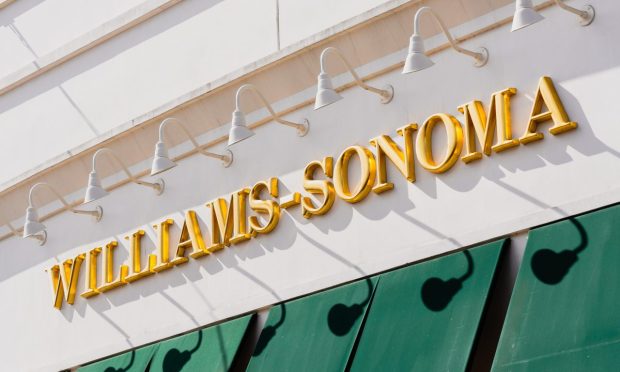Williams-Sonoma ‘Reimagining Stores’ as Omnichannel Shoppers Spend 4x More

After a two-year, 250% jump in its stock price and a year of record sales, kitchen and home furnishing retailer Williams-Sonoma says it is moving to reimagine its digital businesses, which already accounts for 70% of its sales.
In discussing what it calls a “store evolution,” the San Francisco-based retailer that also operates the Pottery Barn and West Elm franchises told investors Wednesday evening (March 16) that it was well positioned within a highly fragmented industry to boosts its top line 25% to $10 billion over the next the three years.
“We are reimagining our stores for the future, transitioning them to design centers and omni fulfillment hubs,” an investor presentation given by CEO Laura Alber and CFO Julie Whalen said. “Our [544] stores are a competitive advantage that supports our ecommerce growth [as] omnichannel customers spend 4 times more and 3 times as frequent than single channel customers.”
As a result, Alber said she was confident that, despite the current economic and geopolitical uncertainty, the company would continue its momentum into 2022 and raise the bar on its recently reported record results, largely on the backs of highly loyal cross-brand existing customers that accounted for a record 60% of its sales for the year that ended Jan. 30.
“We all acknowledge there’s a great deal of uncertainty in the world we live in today, from rising interest rates to global conflicts,” Alber said. “But what gives me confidence is that we operate in an industry that is really large and fragmented where still more than half of the sales are generated from smaller brick-and-mortar retailers and this provides us with a huge opportunity.”
Getting to the Next Level
As the company is flush with cash and supported by a market value of more than $11 billion, Williams-Sonoma’s CFO said long-term macroeconomics trends should continue to favor its business, including a strong housing market that is driving ongoing investment into the home, an accelerating shift to eCommerce and the increasing importance that consumers are placing on sustainably minded retailers.
“While new customer acquisition is always a priority and continues to grow, we believe we have even more upside by increasing our share of wallet with our existing customer base,” Alber said, noting that the company’s cross-brand customers grew faster than so-called single-brand customers.
As a result, Williams-Sonoma said its loyalty program, backed by a 6-month-old cross-brand credit card that works in all of its stores and websites, had delivered “spend and activity that exceeded expectations,” but did not provide further details.
Taken together, the company pointed to three core attributes that it expects will drive its future growth, namely its in-store design capabilities, its digital-first strategy and its values as a female-led business that is widely noted for its commitment to environmental causes and sustainability.
An Enormous Opportunity in B2B
To be sure, there is work to be done, especially at the flagship brand, which accounted for 22% of the company’s combined $2.5 billion of Q4 revenues and nearly 11% same store sales growth. Specifically, while West Elm store comps rose 18%, and Pottery Barn increased over 16% in the most important quarter of the year, Williams-Sonoma branded store comps rose just 4.5%.
It’s partly why the company is revamping stores while shrinking its store count by 6% or 37 locations last year, and also putting energy into new growth areas like its business-to-business (B2B) unit.
“The market for B2B is enormous and no one is really doing a very good job,” Whalen said on the call. “B2B grew over 100% and it just continues to grow. I think I’ve revised my estimates every time I have gotten on this call, so I decided not to give [B2B] estimates anymore because I keep undershooting it and that’s embarrassing as well.”
According to Alber, the B2B business “continues to outperform” having grown its book of business to $753 million in 2021.
“B2B is an underserved and fractured industry and we continue to take share in this white space,” Alber said.
